
| ICE Case Studies
|
|
I.
Case Background |


The conflict in Mali between the tuareg rebels and the Malian government was pushed onto the world stage when the French intervented militarily to stop the rebel advance in January 2013. Although this conflict had not been on the world's mind before the intervention, that does not mean that the conflict in Mali is a new phenomenon. A long history of conflict, which includes Tuareg rebellions that have been occuring on and off for nearly 100 years, have occured with minimal to no international intervention. But this time, the addition of Al-Qaeda backed Islamists in the conflict pushed the French to intervene to save the Malian capital Bamako from getting into the rebels hands. Complex political anddemographic factors are the most important factors, but enviromental factors scuch as climate change play the role of a "threat multiplier" in a region that has a long history of conflict with little signs of relief.
History of Conflict
The Malian government has been fighting on and off the Tuareg tribe, who want to be autonomous from the southern part of Mali where the Malian government is located, for decades now. The Tuareg rebels have had a long history of bad relationship with the states government that they are under; going all the way back to pre-colonial times. The Tuareg were the last group to accept French colonization in 1917. It is important to mention that Mali's current borders are due to french colonial rule and the Tuareg people do not have historical connections to the state of Mali. Mali is one of many situations where colonial rule put different ethnic groups under one states rule, which is another source of conflict. Modernization techniques by the governement were scene as a new form of colonization in the eyes of the Tuaregs as they did not want to give up their traditions of life that they have gotten accustomed to over centuries. After Malian independence, the first revolt was in 1963 which was eventually repressed. During the 1970s and 80s a drought ravaged Northern mali frocing many of the Tuaregs into Algeria and Libya where many became radicalized by Ghadaffy's regime. There they were able to plan a new revolt under Libya's dictators regime and rebellion broke out in Northern mali in 1990 once again (umb). Peace deals that were brokered in 1991 and 2006 did not last. The 1991 deal collapsed because the deal went beyond what the governemnt could actually promise, this among other factors eventually led to the overthrow of the president later that year (umb). This instability gave the Tuareg rebels the ability to stick around and although war stopped periods of sporadic violence did not. Multiple attacks by the Tuareg rebels in 2008 killed dozens of soldiers. Although the Malian government defeated the rebels, the state of Mali continued to be increasingly unstable. In March of 2012, military officials depose the Malian President, saying that he had not been dealing with the Tuareg rebels effectively. This coup came only one month before a round of general elections were scheduled to occur (BBC).
Rebel Gains lead to International Intervention
In April, the rebels took control of Northern Mali and declared independence. In December, a regional military coalition agreed to help retake Northern Mali from the rebels, which had both UN and African Union backing. However, it would take several months to coordinate the effort and the rebels, now controlled by Islamists, have taken over much of central Mali and are preparing to attack the Malian capital. So in January of this year, the French decided to intervene by sending troops to stop the rebel advance. Within a few weeks, they are able to recapture every single town that the rebels held, forcing them back into the desert at the very northern tip of Mali (BBC). Still, small amounts of the rebels still remain within some towns and the threat to these towns have not been eliminated yet. The Malian army, who was overwhelmed by the rebels in the first place, is trying to be given back control over the safety of these towns in Northern Mali by the French troops who freed them from the rebels. There is a question to whether the Malian military is able to do this, as they have shown the inability to do so in the past. Some rebel factions have defected, but most of them moved back into the desert and it is not going to be easy for either French or Malian forces to find them and finish the job (theeconomist).
Causes of Conflict
The instability and conflict in Mali have been caused by many factors. The first factor is the earlier mentioned Tuareg tribesmen who are in control of the National Movement for the Liberation of Azawad (MNLA), which have been calling for a separation from the south for two decades. They controlled many parts of Northern Mali before they decided to team up with an Algerian Salafist offshoot which is linked to AL-Qaeda (AQIM). They used their deal with the MNLA to take over majors cities in Northern Mali such as Gao and Timbuktu; imposing sharia law on these towns citizens while also destroying ancient artifacts in Timbuktu that had been secured for over five centuries. They were on their way to the Malian capital before the French intervention. The AQIM could use any footholds in the region to set up and possibly perpetrate terrorist attacks in the region. Political instability in two regional neighbors, Libya and the Ivory Coast, has helped lezd to instability within Mali. Since the ousting of Gaddafi, influxes of weapons have been heading into northern Mali from Gaddafi’s former stockpiles of weapons that were taken by Libyan rebels. Gaddafi had also been giving refuge to the Tuareg rebels, but when Qaddafi was ousted, these rebels where forced back into Northern Mali. The instability of the Ivory Coast has forced Malians who were living their back into Mali where there is little place for them to go (TP).
Drought and Climate change
The final insecurity is the extended drought that has been going on in both Mali and the broader western Sahel. The drought has forced hundreds of thousands of Malians to migrate away from their villages. The international humanitarian community had been focused on Mali for years before the coup last April. The humanitarian community, specifically Few net, an early warning system for famine’s, predicted the drought and was well prepared for it; however they did not and/or were not able to prepare for the destabilization of the Malian government with the coup last year. The drought has led to famine through many parts of the region. Climate change has exacerbated the problems in Mali; as climate change is called a ‘threat multiplier’ (TP). There is expected to be an increase in desertification and flooding in southern Mali along with mass migration from rural areas to urban areas due to changes in climate. Still, 73.2 percent of Mali’s population live in rural areas and the lack of arable land (only 14%) make resources scare. There is also a lack of diversity with Mali’s economy; with 80 percent of Malians relying on agriculture or fisheries for their livelihoods (both of these areas are vulnerable to climate change)(unu). During the 20 century, there was a dramatic reduction in mean annual rainfall due to the changes of sea surface temperature in the region. The agricultural productivity of Mali is not following demographical trends either. Population will also be a bigger strain on Mali’s recourses in the future. Mali’s population is growing at the highest rate in the world, with the nation’s population tripling over the past 50 years. This trend is expected to continue as their population is expected to double within the next 20 years. Migrating when necessary is also tough for Malians. Mali is one of the poorest nations in the world; so many Malians do not have the resources to move from one place to another which could lead to trapped populations. Changing these things will be difficult, as Mali is resource scarce, landlocked and surrounded by neighbors who cannot help deal with their own economic problems let alone helping Mali. International markets may not be much of a solution either; as those markets for food may be too expensive in the future (Mali is already a big net importer) (TP).
The Tuareg rebels have been fighting the Malian government on and off for decades. However, the recent escalation and French intervention came to be after the rebels made adanavces to take over the northern part of Mali in April 2012. Although the French forces pushed the rebels back to the mountains on mali's border with Algeria, on and off violence still contiunes as the African troops take over for the withdrawing French forces. A complete resolution to the conflict seems unlikely anytime soon.
Mali is located in Sub-Saharan West Africa. Mali is a land-locked state bordering the Ivory Coast, Mauritania, Guinea, Senegal, Algeria, Niger and Burkina Faso. Mali is the 24th largest country in the world in terms of geographical size and is comparable in size to South Africa. The majority of Malian's live in the southern part of the country near the capital Bambako (cia).
Malian government, Tuareg Rebels, French government and military, African Military Force backed by the United Nations, AQIM

-rapid warming that will help multiply all of the problems mentioned below
-deforestation and loss of arable land due to climate change
-continued drying in the region possibly increasing the frequency and duration of droughts due to climate change
-lack of food sources connected to the low amount of arable land available
-average annual rainfall is likely to continue to decrease in the future, meaning even more decreases in agricultural production capabilities in the region (picture courtesy of cia.gov)
-changes in land use may also lead to increased drying in the Sahel, which has been shown to happen in the past
(IPCC)
7. Type of Habitat
Hot and Dry-
The vast majority of Mali is flat, which rises to rolling plains in the north that are convered by sand. The climate in the south is more tropical while the climate in the north is very dry and arid. The amount of rainfall that Mali recieves is not enough many times and droughts are very common. The rainy season is between June and December (reliefweb).
Northern Mali, possible spread to neighboring areas especially the Western Sahara.

figure 2
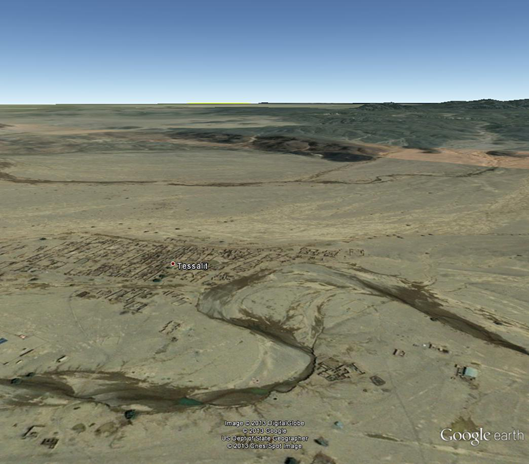
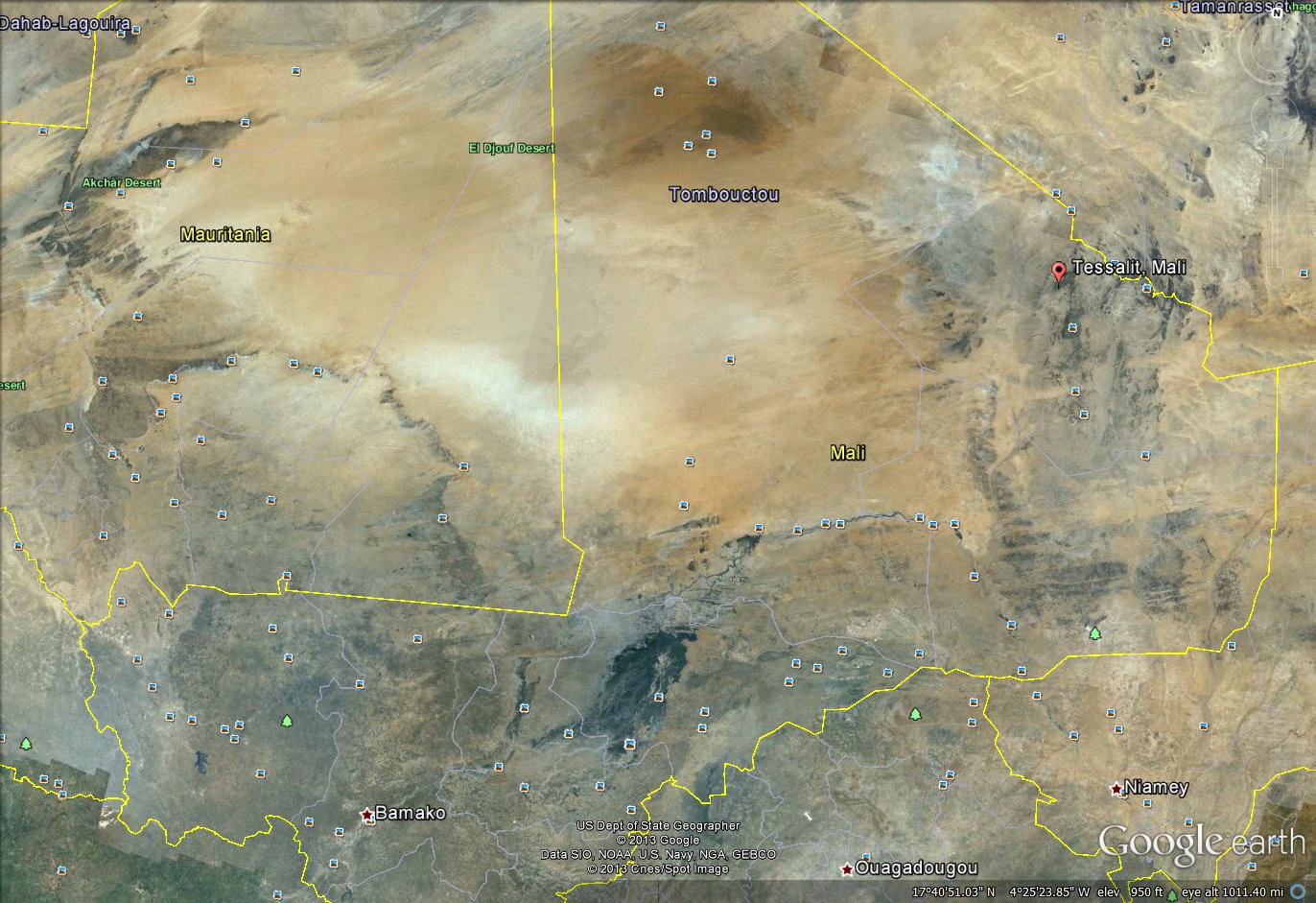 figure 3
figure 3
The picture above to the left shows the small, remote Malian town of Tessalit which is of great strategic importance to both the invading French forces and the Taureg rebels. Tessalit is located in the eastern part of the upper third of Mali, on the opposite side of the country to where the capital Bamako is as shown by the picture above on the right. Whoever is able to control this town and its surrounding areas will have the best access to the Sahara which is both behind and to the east of this picture. Access to this town is minimal; either coming through the vast desert or through the mountain’s which is the only access to this area from the rest of Mali. Although French forces originally took over this border town from the rebels in early February, control over the town went back and forth after Malian soldiers took control over the defensive duties. Tessalit is also the location of the closet airport to the region, giving it strategic importance. The mountains to the south west of the city are also of strategic importance. This map shows the desolate and dangerous terrain which is important in the conflict involving rebels in Mali. The geographical landscape has made it more difficult for French and Malian forces to defeat the rebels and consistently stabilize the area. It has also made it easier for the out-manned yet more experienced rebels to hide in both the mountains and vast desert to prolong the fighting (guardian).
The conflict in Mali is mostly a Civil conflct between the Malian government and the Tuareg rebels. However, gains by the rebels in 2012 and the addition of the AQIM islamist terrorist group to the fighting pushed the French to intervene truning this conflict into an international one as well as a civil one.
There were multiple triggers that led to the eruption of violence in Mali. There have been long standing conflicts in the region, the major one being the Turaeg rebellion, which can be dated back all the way to the early 20th century where the nomadic Turaeg people violently resisted the French colonization of the area. Since then, there have been episodic occurences of violence. One of the sources of the conflict is the Tuareg's belief that some of the Malian governments policies are a new type of colonialism. In the past as well as in the present, the Malian government has also been repressive toward the Tuareg peoples and their claims which as just escalated the violence and did not stop the rebels from having the desire or ability to fight. The Tuareg are also pastoral peoples ad pastoralists have been marginalized in Mali because of the expansion of agriculture. Instability in Libya, Algeria and Niger have also hurt the conflict and have made things even more violent becuase of an influx of weapons from Libya and AQIM soldiers who had been in Libya but were kicked out after the fall of Qaddafi’s regime (umb). The Malian government has also set up a system in which fines are enacted to get access to natural resources; the Malian government claims that this is to reduce environmental degradation but only serves to make the Tuareg more upset and more likely see the Malian governments as corrupt and therefore not a legitimate government to be ruled by. This is also tied into rumors the Malian government has been embezzling the international aid that they have been receiving due to the drought that they are currently been going through (many people on the ground in Mali believe this to be true). All of these factors have played a role in the conflict. The final trigger that caused the rebels to make gains in the northern part of Mali was the coup in the Malian government that took place in Mali in 2012. The addition of the AQIM islamists as well as France's colonial connection to Mali pushed the French to intervene to keep the Malian government from collapsing.
Number of Troops
Mali government- 6,000 to 7,000
French government- 4,000
Other african governments- roughly 7,000
MNLA- 3,000
AQIM- 1,200-3,000
Number of Deaths
Mali has had an estimated 1,000 to 1,500 deaths, captured and missing troops since the rebel advance in April, 2012. 6 Frenchmen have been killed since they intervened in January and dozens have been injured. Chad has had the most casualities out of the regional African forces at 36. Roughly a couple hundred MNLA's have been killed by either the regional forces or by the islamists. Over 700 AQIM members have been killed, the vast majority of them by the French intervention.

(figure 4) Mali's Terrain and the Malian Conflict
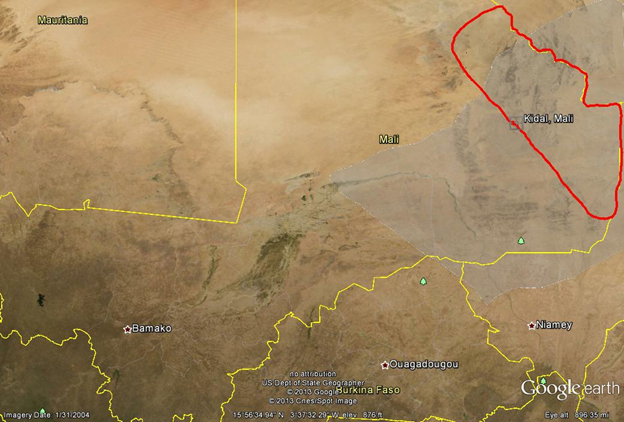
The map pictured above shows a picture of most of Mali and some of its surrounding areas. One thing to point out that is shown by the map is how little arable land (only 14%) Mali has that can be used to grow crops. Climate change has also brought the Sahel desert closer to the south which has led to deforestation making even less land arable throughout the region, including in Mali. The only parts of land that is arable are in the south western part of the state where the Malian capital, Bamako is located. It is clear how arid and dry the rest of the country is, which lacks recourses in a state of one of the fastest growing populations in the world. The area of this map that is lightly filled in grey, is the area of Mali that have been traditional areas of the Tuareg people. Before the Rebels were pushed back by French troops, they had been able to invade and control as far west as central Mali well west of their area, thanks to shaky actions by the Malian government along with an influx of Islamists militants into the region most likely from Libya and the Middle East. The area outlined in red is where the rebels have been pushed back to since the arrival of French troops in Mali. The rebels are now hiding in both the mountains and vast spaces of the desert where it will be hard for the much stronger French forces to find them. The map also shows how difficult it is for the French to find these rebels in such difficult terrain in such a secluded area. Almost all of the agricultural production takes place in the southern part of the country, while the Turaegs live in the northern part of Mali that has no agriculture production capabilities. This helps lead to the beliefs by the Tuaregs that the south is the privileged part of the state while the north is marganilized by that privileged north (umb).
Warming temperatures due to climate change are expected to further destablize areas of the world that are already susceptable to conflict. Some of the fastest warming regions of the world are in the most conflict ridden areas such as central Asia, South America and Sub-Saharan Africa. The below map shows the projected temperature changes throughout the world out to 2050.
figure 6
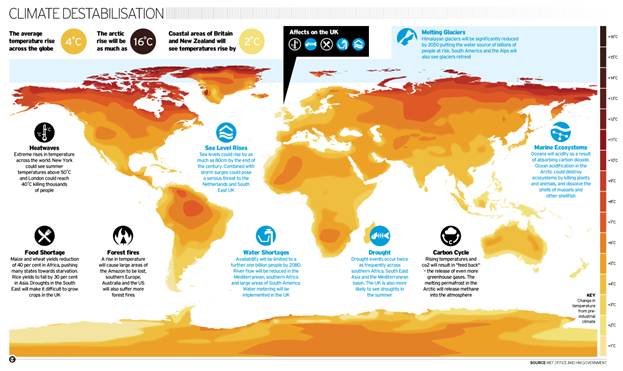
Credit to http://i.telegraph.co.uk/telegraph/multimedia/archive/01507/ClimateMAIN_1507929a.jpg
For the purposes of this case study, it is important to focus on western Africa, the region where Mali is located. The area is expected to have one of the greatest temperature increases throughout the African continent, at high estimates coming in at roughly 7 degrees Celsius. This means that a region that is already destabilized may see even more strife because increased temperatures will likely lead to less arable land and agricultural production (which Mali relies on) as well as increased droughts that will increase problems of malnutrition and disease. This projection shows that this deforestation and resource scarcity will increase in an area that is already destabilized both politically and economically. Mali’s population is also expected to double over the same period of time which will help to further destabilize the region. Food is already scarce within Mali and this problem will most likely increase over time because Mali’s carrying capacity will only decrease over this period as well. Mali will also struggle to import all the food that they need for their growing population because international markets may be too expensive for such a poor nation. Warming projections for Mali show an increasingly destabilized condition for a state that already has needed international aid to help deal with a recent famine that has still not been put into the past as of yet.
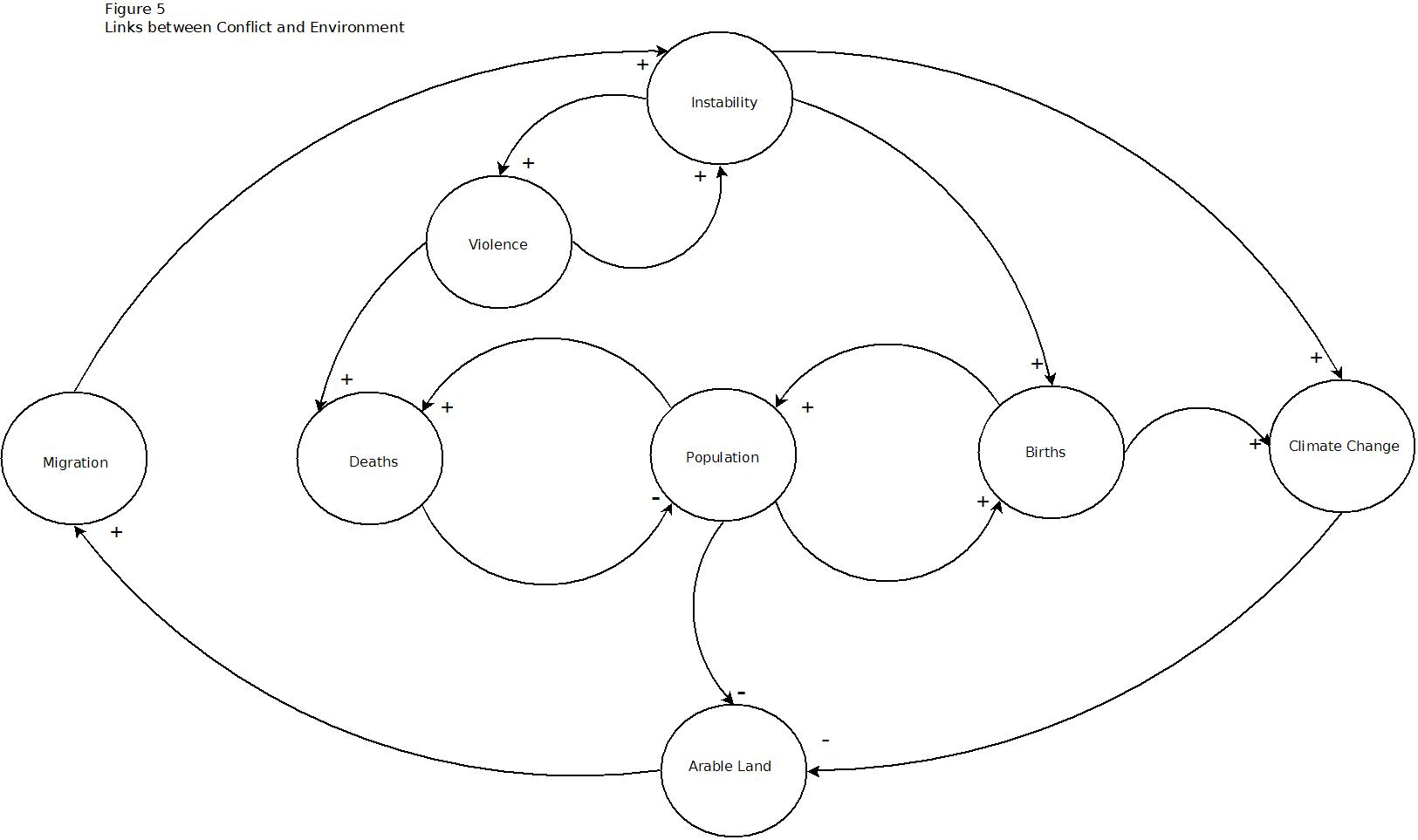
This causal loop diagram above shows the complicated relationship between climate change and the conflict in Mali. There are many different dynamics in the conflict in Mali and this diagram shows just a few of the major one's that directly impact both the conflict and climate change.
Political Instability
First, the political instability of the Malian government which led to a coup last April gave the rebels a chance and belief in an offensive to take over most of northern and central Mali. The instability has also given some sympathy towards the rebels who have been committing acts of violence. The Malian army has also been killing captured rebels for punishment; this is just another example of instability within the Malian government as they have not been able to hold up certain standards for human rights. The violence has also bread more instability, and vice versa which is creating a vicious cycle. The conflict has also forced Malians in the northern part of the country to be displaced. Roughly 175,000 Malians are internally displaced while over 265,000 Malians have fled to neighboring countries to flee the violence. These displaced persons are an environmental problem, as well as political one becuase their is also little to no resources in the places these Malians are being displaced too (trust).
Demographics
Instability may have possibly led to more births, in terms of lack of contraception services within Mali. Mali has one of the lowest rates of access to contraception in Africa, which has much to do with the extreme growth of the Malian population predicted over the next few decades. This increase in Mali's population has also led to less arable land because increases in population also increases climate change which in turn land less arable. There is also less resources at the same time the population is growing. In general, an increase in climate change has led to a decrease in arable land which has led to an increase in migration. This migration has increased instability, although many other factors have also led to this increase in instability such as political changes within Mali and the threat of the Rebels in the north. At the same time, increased instability also leads to more migration. This instability has led to violence which also breads more instability which has of course led to death and effected the population of the region.
Environment
The annual average amounts of rainfall in the Sahel have been steadily dropping since the 1970s; in Mali rainfall amounts have dropped by roughly 20 percent over that time. This has helped lead to droughts that occured in 2005, 2007 and 2010 as well as one that is currently going on now. The lessening of rainfall is likely a direct effect of climate change. The lack of rain, as well as the conflict that is occuring in the area, is leading to malnutrition among itz citizens due to lack of crops beucase of drought. The drought has also lead to the death of many indigenous crops that were rich in vitamins (trust). Climate change has led to drought and deforestation meaning that there is less arable land in Mali to grow crops. Due to this, people who have the ability to migrate have been moving in search for rescourses. This migration has helped lead to instability in regions where this people move to, as there is little place for them to go without tensions growing in areas that they moved to due to lack of recourses and arable land. This instability has helped led to violence and eventually to deaths.
The conflict has always been of strategic interest at a regional level. Conflicts in states such as Libya have helped exasherbate the conflict in Mali and vice versa. Instablity and conflict in Mali has always been a concern for its neighbors. Still they did little to stop the violence until a UN resolution in October 2012 promised an African led peace keeping force in Mali (state.gov)(although this force came to slowly and the French felt that they must intervene). Although Western Africa and Mali have not been seen as much of strategic interest for either the Westen world or the international community, as of late there seems to be some reasons to change that belief. The addition of Islamists into the fray has made Mali of more strategic interest in the world. As Al-Qaeda has been desimated in the Middle East and West Asia they are looking to go other places in the world that they can set-up and launch regional and global attacks from. The Western world does not want this to occur and is trying to scramble to help assist states that are struggling to keep islamists out. The problem is that states such as Mali and Yemen, whose governments are corrupt and weak, have little structures or institutions that will be able to use aid or assistance in a constructive way that will help repel the incoming islamist factions without Western military intervention.
The dispute has yet to be settled. Questions still arise as to whether the Malian troops, the Malian government, and the regional African assistance force will be able to continue the surge that the French troops accomplished when they invaded in January of this year. Due to this, the conflict is still ongoing and the best way for the resolution of this conflict, if possible, would be to address the major problems causing instability in Mali. These include long-standing political grievances in the state, the free flow of weapons and international terrorist organization, drought and climate change (TP). Both top down and bottom up approaches will need to be implemented over a long period of time to fix the political and structural problems that have been plaguing Mali ever since its independence.

References
https://www.cia.gov/library/publications/the-world-factbook/geos/ml.html
http://www.ids.ac.uk/files/dmfile/LHcasestudy13-Mali.pdf
http://rt.com/news/mali-french-troops-conflict-605/
http://www.fao.org/docrep/016/i2856e/i2856e.pdf
http://thinkprogress.org/climate/2012/04/27/469776/mali-migration-militias-coups-and-climate-change/?mobile=nc
http://ourworld.unu.edu/en/mali-the-frontlines-of-climate-change/
http://www.worldbank.org/en/country/mali
http://www.trust.org/item/?map=malis-children-go-hungry-amid-drought-and-conflict
http://www.umb.no/statisk/noragric/seminars/2012/Tor%20A%20benjaminsen.pdf
http://www.economist.com/news/middle-east-and-africa/21571451-french-may-have-stay-bit-longer-they-wish-battle-moves
http://www.bbc.co.uk/news/world-africa-13881978
http://www.guardian.co.uk/world/2013/feb/04/tessalit-geostrategic-sahara-mali-tuareg
http://www.ipcc.ch/pdf/assessment-report/ar4/wg1/ar4-wg1-chapter11.pdf
http://www.state.gov/r/pa/prs/ps/2012/12/202350.htm
http://reliefweb.int/report/mali/impact-malis-rainy-season

7 May 2013